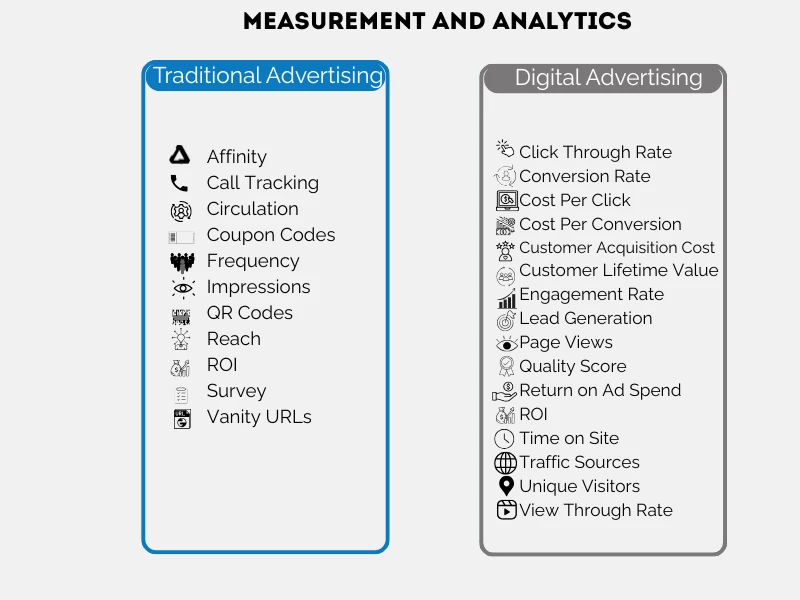Co-Author/Media Buyer: Claire Rogers
Digital advertising may be all the rage today, but traditional ads date back to around 3000 BC. In the U.S., the first print ad ran in the Boston News-Letter in 1704, selling real estate on Long Island. Ironically, the first radio ad, in 1922, also promoted real estate, an apartment building in Queens.
While outdoor ads have been around for over 200 years, the first large-form billboard advertised Barnum & Bailey Circus in 1835. At the time, most were painted or drawn by hand.
While many of the first ad formats are also now available on digital channels, traditional advertising, or non-digital options such as print, linear TV, terrestrial radio, out-of-home, and direct mail, are still a valuable form of sales and marketing communication. Most traditional media channels are best for mass reach and local presence and can enhance brand reputation and trust-building.
3 Main Traditional Ad Channels and Formats
- Outdoor, also called out-of-home or OOH, is large-format advertising that offers maximum visibility and impact while building strong awareness. Wallscapes, bulletins, posters, transit, and station dominations deliver deep reach and frequency for weeks or months at a time. OOH drives your message home on a grand scale, reaching commuters, pedestrians, visitors, and residents where they live, shop, work, and play with customized placement.
- Broadcast or Local TV has the largest broad reach and delivers to the greatest total audience. Television remains the device people spend the most time viewing. Local TV news is the top source for local news and is the most trusted by viewers. It is also the top advertising medium for purchase influence and motivation to learn more about products.
- Broadcast, Local, or Terrestrial radio is listened to by 90% of Americans each week nationally. Messaging can be tied to communities and markets locally. There are a variety of ad formats, and stations can be matched by target demos and advertising initiatives. Radio ads can be consistently flighted with high-frequency weekly schedules across prime dayparts to build brand awareness and promote a call to action. Endorsement radio options personalize and customize messaging for a specific audience by station talent in a natural, conversational, and credible manner.

Key Differences Between Traditional and Digital Advertising
Traditional advertising is a process of reaching out to intended audiences or potential customers using media such as linear television, radio, print, and out-of-home advertising (OOH), or direct mail.
Digital advertising promotes a product or a service online to reach a specific audience. These include display advertising, paid search, paid social, programmatic, native advertising, email advertising, streaming audio and video, Over-the-Top/Connected TV (OTT/CTV), and mobile advertising.
So What’s the Difference?
- Reach and Targeting Capabilities: Traditional advertising can reach a mass audience. While traditional advertising lacks strong targeting capabilities, it offers wide exposure. Digital can offer advanced targeting options in reaching specific demographics and interests.
- Cost Considerations: Traditional advertising is often expensive due to its broad audience and wide reach and frequency. Digital advertising is capable of a wide range of budgets from small daily spending to bigger weekly, monthly, and annual campaigns.
- Engagement and Interactivity: Traditional advertising has less direct engagement and interactivity and is often set in place once published. Digital advertising audiences can share, click, and connect with digital ads that result in awareness, engagement, conversion, retention, and advocacy.
- Measurement and Analytics

Advantages and Disadvantages of Traditional Channels
Whether traditional advertising is right for your brand depends on many factors: industry, product or service, eCommerce, business stage, audience, B2B or B2C. We often recommend a combination of both digital and traditional for most of our clients, depending on those factors, their goals, and budget.
Five key advantages of traditional advertising are:
- High Visibility - TV, Radio, and billboards, and transit ads are unavoidable, resulting in high reach and exposure. These forms of advertising can simultaneously reach a broad and diverse audience.
- Credibility and Trustworthiness - Consumers find companies more credible and trustworthy when they see them on their go-to channels or platforms in the form of TV ads, print ads, and radio commercials
- Brand Recall – Traditional ads and visuals often provide entertainment and offer deeper storytelling, appealing to viewers and leaving a lasting impression.
- Lost in the Crowd – Traditional media channels tend not to be as cluttered as many digital advertising options, helping brands to stand out.
- Tactile Connection – Traditional advertising formats like print offer stronger connections. Consumers can touch and hold physical print ads, creating a sensory experience.
However, there are some challenges. Traditional advertising formats can come with steep costs. TV, radio, and print often require a higher investment, making it more challenging for some clients to afford advertising dollars in the traditional space.
A brand’s prospective audience can be reached through traditional channels, but it’s more difficult to exclude people not within a brand’s preferred audience demographics, limiting targeting capabilities. This broader reach and higher frequency also increase costs. With digital advertising, targeting is easier, and brands can benefit from a variety of budget levels, from small daily spend to bigger weekly, monthly, and annual campaigns.
Unlike digital advertising, conventional ad channels may not be as easily measured. These ad formats are more restrictive in terms of tracking views and engagements, which can lead to difficulty in assessing campaign success.
Longer lead times are usually required for most forms of traditional ads and include higher costs of production. They also limit quick creative and placement adjustments once a campaign is running.
Brand Awareness and Performance Marketing
Traditional advertising is often used to build brand awareness, as it offers mass reach, and the format allows for engagement on a deeper, emotional level through storytelling.
Businesses often employ traditional ads to launch new brands. They may also help tell a story around a rebrand, capturing the attention of current customers and reaching new prospects.
Brand awareness fosters a connection with consumers. While they may not take direct action, they learn what your brand is and remember who you are when they need your solution in the future. This creates trust and familiarity.
When brands are looking for a more performance-based campaign, they may find some challenges with traditional ads. Consumers don’t often take immediate action from an ad they see or hear in print, OOH, or on the radio or TV.
These ad formats limit targeting and lack real-time analytics and reporting, making it difficult to directly tie spend to any outcomes triggered by the traditional ad experience.
If traditional ad channels are a requirement of your advertising strategy, there are ways to optimize them for performance marketing KPIs. Implement trackable elements into your creative: vanity URLs (company.com/TVad), exclusive call tracking phone numbers for different channels, and QR codes in TV or print that lead directly to a landing page. It’s also recommended to layer with digital retargeting, especially with OOH. DRTV advertising can be an effective performance media channel, driving more immediate action.

Measuring Advertising Effectiveness
Traditional advertising is not typically the last touch that leads to a conversion. These ad formats are more often reaching upper funnel prospects, building brand awareness and trust. Although it is more difficult to track traditional ad campaign results, there are KPIs brands should focus on, ways to measure brand marketing metrics, and tie media spend results.
As we’ve mentioned, brand awareness is a key goal for traditional ads. Brand lift studies can be used to measure brand awareness. These studies employ market research to measure the effectiveness of a campaign on awareness and perception by comparing groups that have seen the ad and those that have not.
Reach and frequency are also indicators and measurements of brand growth. GRP, or Gross Rating Points, is a campaign measurement formula. GRP equals the percentage of people reached multiplied by the average number of times they are shown the ad, which is frequency. The higher the GRP, the greater the brand awareness.
When running direct response ads with trackable phone numbers or URLs, you can track call volume and web traffic to those traditional ads. QR codes are also valuable for tracking direct response ads. If unique tracking is not an option for TV spots, time-based correlation can be used. This entails looking at web traffic or call volume 1 – 15 minutes after a spot airs.
Integrated Marketing Strategies
An ideal advertising strategy includes a media plan combining traditional and digital media. Embracing the advantages of both options offers enhanced reach and frequency, cross-channel advertising synergy and reinforcement, and improved brand credibility and trust.
An omnichannel and full-funnel media plan reaches all levels of the customer journey. It builds brand awareness and optimizes lead generation and conversions with performance marketing. Ad messaging or CTAs will differ, as will the channels for placement, but they will enable brands to reach a larger, qualified audience. This traditional and digital marketing integration strategy delivers better ROI.
Consumers don’t just live in traditional ad worlds or separately in the digital realm. Each interaction a prospect has with a brand reinforces messaging and can lead to action. Hearing an ad on a local radio network, then seeing a TV ad while watching local news, can be reinforced by the viewer later seeing the same ad while streaming their favorite weekly TV series through OTT/CTV and then searching for the product/service with a Google search.
We highly recommend integrated media plans for our clients and have seen great success with this strategy. Recently, one of our credit union clients ran a multi-channel annual campaign to build awareness in their current market as well as a new market. At the same time, they advertised to increase new memberships and applications for their product offerings. The combination of traditional and digital components resulted in increased brand lift in all markets, a 17% improvement in new memberships, and a 78% increase in home equity applications.
For marketers leading advertising, communicating this strategy to leadership to gain buy-in may require explaining the role of traditional and digital advertising in achieving your business objectives. Align recommended advertising strategies with your company goals. Communicate how traditional advertising builds brand equity, driving long-term growth, and digital delivers performance, both have value in business growth, balancing reach with ROI.
Leadership Communication

Traditional advertising in our digital age has many benefits, ad formats, and channel options to support most brands’ marketing goals.
Discuss the benefits and challenges of incorporating traditional advertising into your media plan with your media buying and creative teams. Understand the best ad formats and channels to reach your audience with the right messaging, in the right place, to achieve your goals.
Modern marketers bridge traditional and digital advertising to create an omnichannel strategy that reaches all levels of their potential customers, elevating their marketing and advertising efforts




